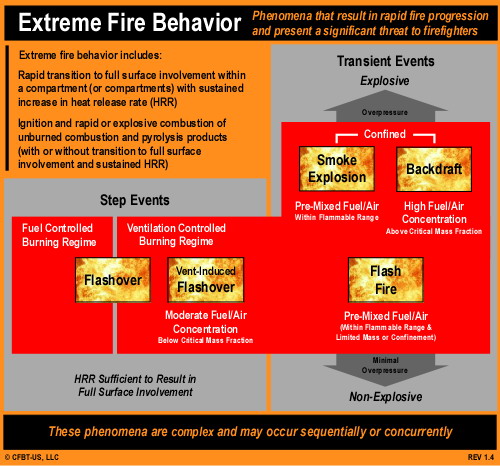Battle Drill Part 3
Sunday, February 21st, 2010A Quick Review
As discussed in the previous posts in this series, military battle drills are an immediate response to enemy contact that requires fire and maneuver in order to succeed. Battle drills are initiated with minimal commands from the unit leader. Soldiers or marines execute preplanned, sequential actions in response to enemy contact (see Figure 1).
Figure 1. Battle Drill

Battle Drill Part 2 addressed the appropriate reaction of a team of firefighters on a primary hoseline when confronted with rapidly worsening fire conditions that are not readily controllable once they occur (e.g., flashover, wind driven fire conditions). As when a military unit is ambushed, the fire and maneuver of battle drill involves more than one weapon. This post will address the role and reaction of backup lines in the extreme fire behavior battle drill.
Backup Lines
Once a hoseline has been deployed for fire attack it is good practice to stretch a backup line. Klaene and Sanders (2008) observe that backup lines are needed to protect the crew on the initial attack line and to provide additional flow if needed (p. 216). Unfortunately, many firefighters see the backup line as simply another attack line and miss the first and primary function of this hoseline to protect crews on primary hoselines.
The first priority in fire attack operations is to get a hoseline in position to apply water effectively to the fire. To this end, hoselines are deployed in series (attack line first, then backup line) not in parallel, where both lines are attempting to advance and maneuver in the same space. The crew of the backup line can often assist in pulling up additional hose for the attack line (particularly when crews are lightly staffed). As illustrated in Figure 2, the backup line is positioned to protect the means of egress and if necessary support fire attack.
Figure 2. Attack and Backup Line Placement

Extreme Fire Behavior Battle Drill
As discussed in Battle Drill Part 2, the thermal insult experienced in an extreme fire behavior event is dependent on temperature (of gases and compartment linings) and flow of hot gases. The higher the temperature and faster the speed of gas flow, the higher the heat flux. Survival requires that crews on hoselines extinguish or block the flames, cool hot gases, and maneuver out of the flow path to a point of egress or area of safer refuge.
Crews engaged in fire attack or search are often first to encounter rapidly deteriorating fire conditions. Hose Handling and Nozzle Technique Drill 8 outlined the immediate actions that should be taken to support a tactical withdrawal under severe fire conditions. In these circumstances, the crew staffing the backup line has a critical role in supporting withdrawing crews.
Fire conditions that are beyond the capability of a single hoseline may be controlled by the higher flow rate from multiple lines. As noted by Klaene and Sanders (2008) one of the functions of backup lines is to provide additional flow if needed (p. 216). The attack line and backup line operating in a coordinated manner may be able to control fire conditions and allow continuation of fire attack. If this is the case, these lines should be reinforced by deployment of one or more additional backup lines.
If fire conditions cannot be controlled, and the attack line must be withdrawn while maintaining water application to protect the crew, the crew on the backup line can aid in withdrawal of attack and/or search hoselines. If the hoseline is not withdrawn as the firefighter on the nozzle retreats, the hose may kink or become exposed to flames (either of which may result in loss of water supply to the nozzle).
While the attack or search crew is likely to be first to encounter worsening fire conditions, this is not always the case. Depending on fire location and building configuration, fire spread may cut off the attack or search line from behind. In this situation, the backup line becomes the primary means of defense for operating crews.
Regardless of how deteriorating conditions develop, safe and effective tactical withdrawal requires a coordinated effort between interior crews and as soon as possible, report of conditions to Command and if necessary transmit a Mayday message.
Drill 9-Extreme Fire Behavior Battle Drill-The Backup Line: Key hose handling and nozzle techniques when faced with extreme fire behavior are the ability to apply long pulses of water fog or maintaining a continuous flow rate while maneuvering backwards. However, the backup line may initially need to advance to support fire attack, and then if necessary cover and support other crews as they withdraw.
Hose Handling & Nozzle Technique Drill 9 Instructional Plan
Skill in operation and maneuver of a single hoseline is a foundational firefighting skill. However, in the extreme fire behavior battle drill, coordinated operation of the attack and backup line is essential, making Hose Handling & Nozzle Technique Drill 9 an important step in skill development.
References
Klaene, B. & Sanders, R. (2008) Structural Firefighting Strategy and Tactics (2nd ed.). Sudbury, MA: Jones & Bartlett.


















